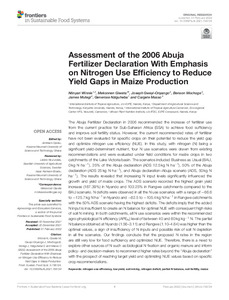| dc.contributor.author | Winnie, N. |
| dc.contributor.author | Giweta, M. |
| dc.contributor.author | Gweyi-Onyango, J. |
| dc.contributor.author | Mochoge, B. |
| dc.contributor.author | Mutegi, J. |
| dc.contributor.author | Nziguheba, G. |
| dc.contributor.author | Masso, C. |
| dc.date.accessioned | 2022-02-22T10:27:21Z |
| dc.date.available | 2022-02-22T10:27:21Z |
| dc.date.issued | 2022 |
| dc.identifier.citation | Winnie, N., Giweta, M., Gweyi-Onyango, J., Mochoge, B., Mutegi, J., Nziguheba, G. & Masso, C. (2022). Assessment of the 2006 Abuja fertilizer declaration with emphasis on nitrogen use efficiency to reduce yield gaps in maize production. Frontiers in Sustainable Food Systems, 5: 758724, 1-13. |
| dc.identifier.issn | 2571-581X |
| dc.identifier.uri | https://hdl.handle.net/20.500.12478/7362 |
| dc.description.abstract | The Abuja Fertilizer Declaration in 2006 recommended the increase of fertilizer use from the current practice for Sub-Saharan Africa (SSA) to achieve food sufficiency and improve soil fertility status. However, the current recommended rates of fertilizer have not been evaluated for specific crops on their potential to reduce the yield gap and optimize nitrogen use efficiency (NUE). In this study, with nitrogen (N) being a significant yield-determinant nutrient, four N use scenarios were drawn from existing recommendations and were evaluated under field conditions for maize crops in two catchments of the Lake Victoria basin. The scenarios included Business as Usual (BAU, 0 kg N ha−1), 25% of the Abuja declaration (ADS 12.5 kg N ha−1), 50% of the Abuja declaration (ADS 25 kg N ha−1), and Abuja declaration–Abuja scenario (ADS, 50 kg N ha−1). The results revealed that increasing N input levels significantly influenced the growth and yield of maize crops. The ADS scenario recorded the highest grain yield increase (167.39%) in Nyando and 103.25% in Rangwe catchments compared to the BAU scenario. N deficits were observed in all the N use scenarios with a range of −66.6 to −125.7 kg N ha−1 in Nyando and −62.5 to −105.4 kg N ha−1 in Rangwe catchments with the 50% ADS scenario having the highest deficits. The deficits imply that the added N input is insufficient to create an N balance for optimal NUE with consequent high risks of soil N mining. In both catchments, all N use scenarios were within the recommended agro-physiological N efficiency (APEN) level of between 40 and 60 kg kg−1 N. The partial N balance obtained at Nyando (1.56–3.11) and Rangwe (1.10–4.64) was higher than the optimal values, a sign of insufficiency of N inputs and possible risk of soil N depletion in all the scenarios. Our findings conclude that the proposed N rates in the region are still very low for food sufficiency and optimized NUE. Therefore, there is a need to explore other sources of N such as biological N fixation and organic manure and inform policy- and decision-makers to recommend higher rates beyond the “Abuja declaration” with the prospect of reaching target yield and optimizing NUE values based on specific crop recommendations. |
| dc.description.sponsorship | International Nitrogen Management System |
| dc.format.extent | 1-13 |
| dc.language.iso | en |
| dc.subject | Nitrogen |
| dc.subject | Yields |
| dc.subject | Soils |
| dc.subject | Soil Fertility |
| dc.subject | Maize |
| dc.title | Assessment of the 2006 Abuja fertilizer declaration with emphasis on nitrogen use efficiency to reduce yield gaps in maize production |
| dc.type | Journal Article |
| cg.contributor.affiliation | International Institute of Tropical Agriculture |
| cg.contributor.affiliation | Kenyatta University |
| cg.contributor.affiliation | African Plant Nutrition Institute, Kenya |
| cg.coverage.region | Africa |
| cg.coverage.region | Africa South of Sahara |
| cg.coverage.region | East Africa |
| cg.coverage.country | Kenya |
| cg.coverage.hub | Central Africa Hub |
| cg.researchtheme | Natural Resource Management |
| cg.identifier.bibtexciteid | WINNIE:2022 |
| cg.isijournal | ISI Journal |
| cg.authorship.types | CGIAR and developing country institute |
| cg.iitasubject | Agronomy |
| cg.iitasubject | Food Security |
| cg.iitasubject | Maize |
| cg.iitasubject | Plant Breeding |
| cg.iitasubject | Plant Production |
| cg.iitasubject | Soil Fertility |
| cg.journal | Frontiers in Sustainable Food Systems |
| cg.notes | Open Access Journal; Published online: 01 Feb 2022 |
| cg.accessibilitystatus | Open Access |
| cg.reviewstatus | Peer Review |
| cg.usagerightslicense | Creative Commons Attribution 4.0 (CC BY 0.0) |
| cg.targetaudience | Scientists |
| cg.identifier.doi | https://dx.doi.org/10.3389/fsufs.2021.758724 |
| cg.iitaauthor.identifier | Generose Nziguheba: 0000-0003-4227-2242 |
| cg.iitaauthor.identifier | Cargele Masso: 0000-0002-3980-6832 |
| cg.futureupdate.required | No |
| cg.identifier.issue | 758724 |
| cg.identifier.volume | 5 |

